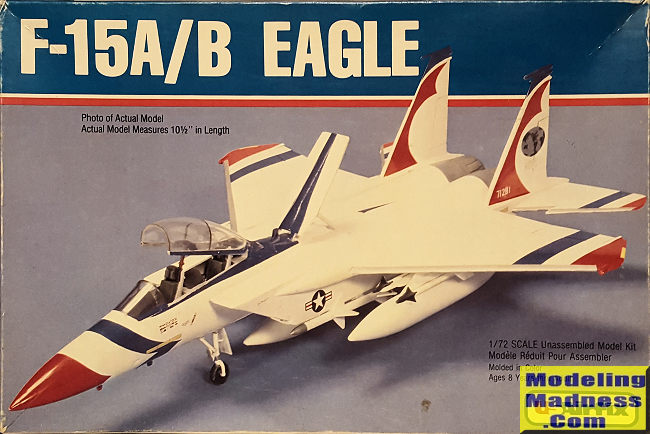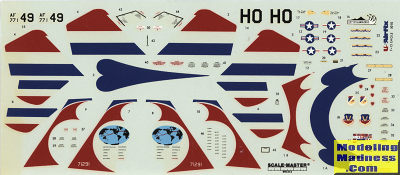
US Airfix 1/72 F-15A/B Eagle
| KIT #: | 5010 |
| PRICE: | $2.00 'used' |
| DECALS: | Two options |
| REVIEWER: | Scott Van Aken |
| NOTES: | 1980 release |

| HISTORY |
The McDonnell Douglas F-15 Eagle is an American twin-engine, all-weather tactical fighter aircraft designed by McDonnell Douglas (now part of Boeing). Following reviews of proposals, the United States Air Force selected McDonnell Douglas's design in 1967 to meet the service's need for a dedicated air superiority fighter. The Eagle first flew in July 1972, and entered service in 1976. It is among the most successful modern fighters, with over 100 victories and no losses in aerial combat, with the majority of the kills by the Israeli Air Force.
The Eagle has been exported to Israel, Japan, and Saudi Arabia. The F-15 was originally envisioned as a pure air-superiority aircraft. Its design included a secondary ground-attack capability that was largely unused. The aircraft design proved flexible enough that an improved all-weather strike derivative, the F-15E Strike Eagle, was later developed, entered service in 1989 and has been exported to several nations. As of 2021, the aircraft is being produced in several variants.Expect to see the Eagle in the skies for many years to come. The USAF, realizing that the F-35 simply wasn't able to do the strike mission well enough, and with no replacement for the F-15E in the pipeline, has ordered 100 updated F-15Es, the F-15EX, which is now undergoing testing.
| THE KIT |
I'm not sure exactly when US Airfix came into being. I do know that prior and after, Airfix kits were repackaged by MPC. I'm sure someone knows, but it isn't I. Regardless, Airfix released this kit in 1978 and this one is dated 1980. Molded in white plastic (undoubtedly due to the scheme), it is fine raised panel lines with raised detail for the instrument panel and side consoles.
You are able to do either an F-15A or two seat F-15B, and to accomplish that, you are provided with different upper fuselage sections. As is standard with Airfix kit of the time, the seat is basically a shape onto which you place crew figures. There are control sticks for each of the tubs. If doing the A, then an electronics bay is in place of the rear seat.
The fuselage is split into upper and lower halves with the nose gear well molded in place. The interior bits are installed and the halves closed. Intakes are two piece and are fairly shallow. Before attaching the upper insert, you need to attach the rear cockpit section depending on which variant you are building. The nose cone is separate and while it don't think this needs nose weight, it would be wise to leave that off until the airframe is complete just to be sure.
 Wings
are upper and lower halves with the upper half containing the flaps and
ailerons. Holes for the wing pylons are already opened up. Tailplanes are a
single piece as are the fins. Note that the fins are of the production
version, while this kit is of a preproduction prototype so should have both
fin balances the same thickness. I've included a photo of this aircraft in
this scheme. Note that the nose probe was not always carried, but the
aircraft never got the production fin tip during its long life as a test
plane.
Wings
are upper and lower halves with the upper half containing the flaps and
ailerons. Holes for the wing pylons are already opened up. Tailplanes are a
single piece as are the fins. Note that the fins are of the production
version, while this kit is of a preproduction prototype so should have both
fin balances the same thickness. I've included a photo of this aircraft in
this scheme. Note that the nose probe was not always carried, but the
aircraft never got the production fin tip during its long life as a test
plane.
The kit's landing gear is actually pretty nice, though the main wheels could use replacement as the hub detail is fairly shallow. You can leave the gear off until the airframe is painted if you so wish, but if doing the white scheme, it would be prudent to install the gear and doors as everything there save the wheels will be white. The kit also has a lowered boarding ladder, though it was not always seen when the plane was on the ground.
The final items include three fuel tanks; two pylon
and one centerline. Airfix provides weapons that include four Sparrow for
the fuselage and Sidewinders for the wing pylons. You can also pose the
 canopy
open or closed if you so wish. Note that rarely will one see the box art
plane with weapons or even pylons so keep that in mind.
canopy
open or closed if you so wish. Note that rarely will one see the box art
plane with weapons or even pylons so keep that in mind.
Instructions are well done and provide generic paint information. Markings are by Scalemaster and include not only the box art plane, but also the 49th FW boss bird in a standard early F-15 scheme. If you don't like the kit decal choices, there is no lack of early F-15A/B decal options out there.
| CONCLUSIONS |
| REFERENCES |
https://en.wikipedia.org/wiki/McDonnell_Douglas_F-15_Eagle
May 2021
Copyright ModelingMadness.com. All rights reserved. No reproduction without express permission.
My thanks to me for picking this one up on sale.
If you would like your product reviewed fairly and fairly quickly, please contact the editor or see other details in the Note to Contributors.